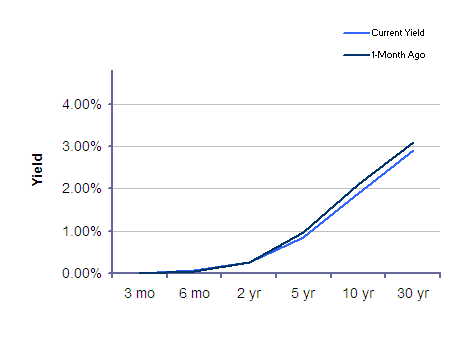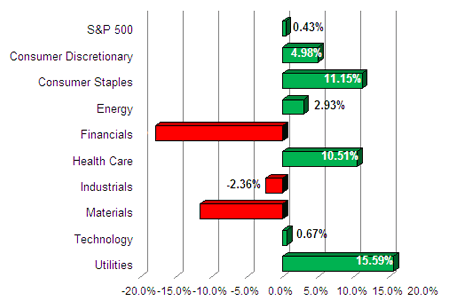Market Commentary by Scott J. Brown, Ph.D., Chief Economist

Good news on the home front was offset somewhat by concerns about developments overseas as the broad market finished a volatile year essentially unchanged from where it began.
Consumers were generally upbeat, with the Conference Board’s monthly consumer confidence index for December rising to 64.5, up from a 55.2 reading in November and reaching levels last seen in the spring. That confidence, aided by deep discounting and extended hours from retailers, translated into better than expected holiday sales. A shopping center trade group said revenues rose about 3.8% in November and December from a year ago.
Other domestic indicators also were positive. The Labor Department’s four-week average of unemployment claims fell to its lowest level since June 2008, manufacturing activity in the Midwest remained steady in December after rising sharply in November, and a national index of pending home sales index rose to its highest level in more than 18 months.
News from abroad was less encouraging. Demand for Italian government debt at Thursday’s auction was weaker than expected, sending the euro to its lowest level against the yen in 10 years and an 11-month low against the dollar. The European currency has dropped about 3.8% in December, with investors worrying that one or more of the major economies in the 17-nation currency bloc may have their credit ratings cut. Meanwhile, Chinese manufacturing activity declined for the second consecutive month in December. With Europe struggling and the U.S. recovery proceeding very slowly, China’s economy has become increasingly important to the global outlook.
Going into the New Year, the U.S. economy is showing signs of momentum. The first week brings reports on manufacturing, construction spending, factory orders, jobless claims, and, on Friday, the unemployment rate.
Indices
| Last | Last Week | YTD return % | |
| DJIA | 12287.04 | 12169.65 | 6.13% |
| NASDAQ | 2613.74 | 2599.45 | -1.48% |
| S&P 500 | 1263.02 | 1254 | 0.43% |
| MSCI EAFE | 1393.45 | 1393.43 | -15.97% |
| Russell 2000 | 744.98 | 745.51 | -4.93% |
Consumer Money Rates
| Last | 1-year ago | |
| Prime Rate | 3.25 | 3.25 |
| Fed Funds | 0.04 | 0.21 |
| 30-year mortgage | 3.95 | 5.01 |
Currencies
| Last | 1-year ago | |
| Dollars per British Pound | 1.540 | 1.549 |
| Dollars per Euro | 1.294 | 1.319 |
| Japanese Yen per Dollar | 77.710 | 81.820 |
| Canadian Dollars per Dollar | 1.022 | 1.000 |
| Mexican Peso per Dollar | 13.994 | 12.366 |
Commodities
| Last | 1-year ago | |
| Crude Oil | 99.65 | 91.12 |
| Gold | 1534.93 | 1411.98 |
Bond Rates
| Last | 1-month ago | |
| 2-year treasury | 0.26 | 0.27 |
| 10-year treasury | 1.89 | 2.11 |
| 10-year municipal (TEY) | 2.79 | 3.36 |
Treasury Yield Curve – 12/30/2011
S&P Sector Performance (YTD) – 12/30/2011
Economic Calendar
| January 3rd |
— |
ISM Manufacturing Index (December) FOMC Minutes (December 13th) |
| January 5th |
— |
ISM Non-Manufacturing Index (December) |
| January 6th |
— |
Employment Report (December) |
| January 16th |
— |
Dr. Martin Luther King, Jr. Holiday (markets closed) |
| January 24th-25th |
— |
FOMC Policy Meeting |
Important Disclosures
Past performance is not a guarantee of future results. There are special risks involved with global investing related to market and currency fluctuations, economic and political instability, and different financial accounting standards. The above material has been obtained from sources considered reliable, but we do not guarantee that it is accurate or complete. There is no assurance that any trends mentioned will continue in the future. While interest on municipal bonds is generally exempt from federal income tax, it may be subject to the federal alternative minimum tax, state or local taxes. In addition, certain municipal bonds (such as Build America Bonds) are issued without a federal tax exemption, which subjects the related interest income to federal income tax. Investing involves risk and investors may incur a profit or a loss.
US government bonds and treasury bills are guaranteed by the US government and, if held to maturity, offer a fixed rate of return and guaranteed principal value. US government bonds are issued and guaranteed as to the timely payment of principal and interest by the federal government. Treasury bills are certificates reflecting short-term (less than one year) obligations of the US government.
Commodities trading is generally considered speculative because of the significant potential for investment loss. Markets for commodities are likely to be volatile and there may be sharp price fluctuations even during periods when prices overall are rising. Specific sector investing can be subject to different and greater risks than more diversified investments.
Tax Equiv Muni yields (TEY) assume a 35% tax rate on triple-A rated, tax-exempt insured revenue bonds.
![]() Material prepared by Raymond James for use by its financial advisors.
Material prepared by Raymond James for use by its financial advisors.
The information contained herein has been obtained from sources considered reliable, but we do not guarantee that the foregoing material is accurate or complete. Data source: Bloomberg, as of close of business December 22nd, 2011.
©2011 Raymond James Financial Services, Inc. member FINRA / SIPC.





